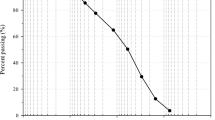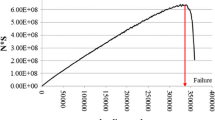Abstract
The purpose of this paper is to evaluate fatigue cracking and rutting performance of two asphalt mixtures with 1) Electric Arc Furnace (EAF) and 2) Basic Oxygen Furnace (BOF) steel slag as 100% recycled aggregate in comparison to hot-mix asphalt concrete mixture (HMA). Fatigue cracking performance was assessed through 3D FEM structural analysis methods of Layered Viscoelastic Continuum Damage (LVECD) based on Viscoelastic Continuum Damage (VECD) material modeling derived through laboratory dynamic modulus and direct tension cyclic fatigue tests. Rutting resistance was evaluated by using laboratory Incremental Repeated Load Performance Deformation (IRLPD) and full-scale Accelerated Pavement Tests (APT). The results of laboratory testing and mechanistic analysis showed better rutting resistance of asphalt pavement with EAF aggregates in comparison to HMA pavement while pavement with BOF aggregates exhibited about the same performance. Additionally, asphalt pavement with BOF aggregates, HMA, and pavement with EAF aggregates manifested fatigue cracking performance in descending order. The findings of this study can be used as a guide for the development of recycled asphalt mixtures containing slag aggregates acquired from steel production.
Similar content being viewed by others
References
Chehab G, Kim YR, Schapery RA, Witczack M, Bonaquist R (2002) Time-temperature superposition principle for asphalt concrete mixtures with growing damage in tension state. Journal of Association of Asphalt Paving Technologists 71:559–593
Gibson N, Qi X, Shenoy A, Al-Khateeb G, Kutay ME, Andriescu A, Stuart K, Youtcheff J, Harman T (2012) Performance testing for superpave and structural validation. Federal Highway Administration, USA
Hong Y, Boon K, Loi S, Fang T, Chong Y (2015) Steel slag aggregate for asphalt pavement. 9th International Conference on Road and Airfield Pavement Technology, Dalian, China
Huang YH (2004) Pavement analysis and design. Upper Saddle River, New Jersey
Kalyoncu RS (2000) Slag-iron and steel: 2000 annual review. U.S Geol Surv Miner Yearb, USA, 1–7
Kavussi A, Qazizadeh MJ (2014) Fatigue characterization of asphalt mixes containing electric arc furnace (EAF) steel slag subjected to long term aging. Construction and Building Materials 72:158–166, DOI: https://doi.org/10.1016/j.conbuildmat.2014.08.052
Kim KN, Jo SH, Kim NS, Kim HW (2017) A study on steel slag asphalt concrete design method considering density and absorption. International Journal of Highway Engineering 20(1):59–67, DOI: https://doi.org/10.7855/IJHE.2018.20.1.059
Kim YR, Little DN (1990) One-dimensional constitutive modeling of asphalt concrete. ASCE Journal of Engineering Mechanics 116(4): 751–772
Lee JS, Kim YR (2013) Use of cyclic direct tension tests and digital imaging analysis to evaluate moisture susceptibility of warm mix asphalt concrete. Transportation Research Record: Journal of the Transportation Research Board 2372(1):61–71, DOI: https://doi.org/10.3141/2372-08
Lee JS, Kim YR (2015) Use of mechanistic models to investigate fatigue performance of asphalt mixtures: Effects of asphalt mix design targets and compaction. Transportation Research Record: Journal of the Transportation Research Board 2507(1):109–119, DOI: https://doi.org/10.3141/2507-12
Lee JS, Kim YR (2016) Determineing specimen geometry of cylindrical specimens for direct tension fatigue testing of asphalt concrete. Journal of Testing and Evaluation 45(2):613–623, DOI: https://doi.org/10.1520/JTE20140357
Levenburg E, Uzan J (2004) Triaxial small-strain viscoelastic-viscoplastic modeling of asphalt aggregate mixes. Mechanics of Time-Dependent Materials 8(4):365–384, DOI: https://doi.org/10.1007/s11043-004-1592-1
Neo H-F, Harvey JT, Underwood BS, Ossa-Lopez A (2022) Pavement Fatigue damage simulations using second-generation mechanistic-empirical approaches. Transportation Research Record: Journal of the Transportation Research Board 2676(1):1–17, DOI: https://doi.org/10.1177/03611981211027152
Pasetto M, Baldo N (2011) Mix design and performance analysis of asphalt concretes with electric arc furnace slag. Construction and Building Materials 25(8):3458–3468, DOI: https://doi.org/10.1016/j.conbuildmat.2011.03.037
Shen DH, Wu CM, Du JC (2009) Laboratory investigation of basic oxygen furnace slag for substitution of aggregate in porous asphalt mixture. Construction and Building Materials 23(1):453–461, DOI: https://doi.org/10.1016/j.conbuildmat.2007.11.001
Underwood BS, Baek CM, Kim YR (2012) Simplified viscoelastic continuum damage model as an asphalt concrete fatigue analysis. Transportation Research Record: Journal of the Transportation Research Board 2296(1):36–45, DOI: https://doi.org/10.3141/2296-04
Underwood BS, Kim YR, Guddati MN (2006) Characterization and performance prediction of ALF mixtures using a viscoelastoplastic continuum damage model. Journal of Association of Asphalt Paving Technologists 75:577–636
Underwood BS, Kim YR, Guddati MN (2010) Improved calculation method of damage parameter in viscoelastic continuum damage model. International Journal of Pavement Engineering 11(6):459–476, DOI: https://doi.org/10.1080/10298430903398088
Viman L, Ahmed AW, Said SF, Lind L (2016) Evaluation of slag as aggregates in asphalt mixtures. E&E congress 2016. 6th Eurasphalt & Eurobitume Congress, DOI: https://doi.org/10.14311/EE.2016.238
Wang YD, Keshavarzi B, Kim YR (2018) Fatigue performance prediction of asphalt pavement with flexpave, the S-VECD model and Dr failure criterion. Transportation Research Record: Journal of the Transportation Research Board 2672(40):217–227, DOI: https://doi.org/10.1177/0361198118756873
Wang YD, Ghanbari A, Underwood BS, Kim YR (2020) Development of preliminary transfer functions for performance predictions in felxp-pave. Construction and Building Materials 0950–0618, DOI: https://doi.org/10.1016/j.conbuildmat.2020.121182
Wen H, Wu S, Bhusal S (2015) Performance evaluation of asphalt mixes containing steel slag aggregate as a measure to resist studded tire wear. Journal of Materials in Civil Engineering 28(5)
Acknowledgments
Not Applicable
Author information
Authors and Affiliations
Corresponding author
Rights and permissions
About this article
Cite this article
Lee, E.J., Park, H.M., Suh, Y.C. et al. Performance Evaluation of Asphalt Mixtures with 100% EAF and BOF Steel Slag Aggregates Using Laboratory Tests and Mechanistic Analyses. KSCE J Civ Eng 26, 4542–4551 (2022). https://doi.org/10.1007/s12205-022-1985-1
Received:
Revised:
Accepted:
Published:
Issue Date:
DOI: https://doi.org/10.1007/s12205-022-1985-1




